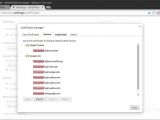Google developers have released a new stable version of the Google Chrome browser and the version has now evolved to 39.0.2171.95. This is more about a Flash update that has been implemented across all versions, but there are some other improvements as well.
Some of the Linux users might already know this, but it's worth mentioning nonetheless. Adobe has abandoned all Flash development for the Linux platform and the Google devs have picked up their work, but only for maintenance purposes.
Each time a new Google Chrome version arrives with a Flash update, the Linux users actually get a few security fixes and nothing else.
The same is true for the current Google Chrome 39.x branch, which has come with Flash 16.0.0.235 for Windows and Mac OS X, and Flash 11.2.202.425 for the Linux counterpart.
On the other hand, it's clear that Flash doesn't really have a future anymore, at least not on the open source platform and we might be heading to an HTML5-only release. It won't happen very soon, but it's coming.
Google Chrome 39 stable is not boring, but it's not all that interesting either
The changes implemented in this browser usually follow a very clear path. They are first implemented in the Dev release, then they arrive in the Beta, and if everything works, then we’ll get to see them in the Stable branch.
The Flash update covers a number of security issues that have been detailed in another separate article. It's important to know that this piece of software really needs to be kept up to date in order to ensure the safety of the users.
"Install libpnacl_irt_shim.a into the correct location. After we changed the PNaCl toolchain layout, this library was being installed to the wrong location. Actually, it was worse -- the directory didn't exist, so the library was being copied into a file called linux_pnacl / lib-. The correct location is now linux_pnacl / translator / / lib."
"Previously, there was a hack/optimization where when shrinking a pile, there would be no invalidations. Unfortunately, this hack's time has come due. When zooming out, recorded pixels outside of the pile's newly shrunken bounds can get used, causing pixels from old frames to get incorrectly sampled, causing bogus hairlines. To fix this, issue invalidations for previously exposed content in the same way that invalidations are currently issues for newly exposed content," reads the official changelog.
These are just a couple of the fixes that you will find in the latest version of the browser and a number of smaller changes are present as well. You can download Google Chrome 39.0.2171.95 for Linux from Softpedia, or the Windows and Mac OS X versions from the same location.

 14 DAY TRIAL //
14 DAY TRIAL // 








